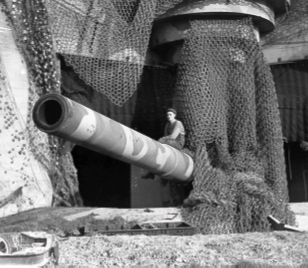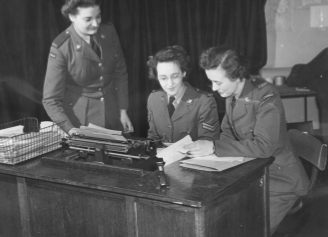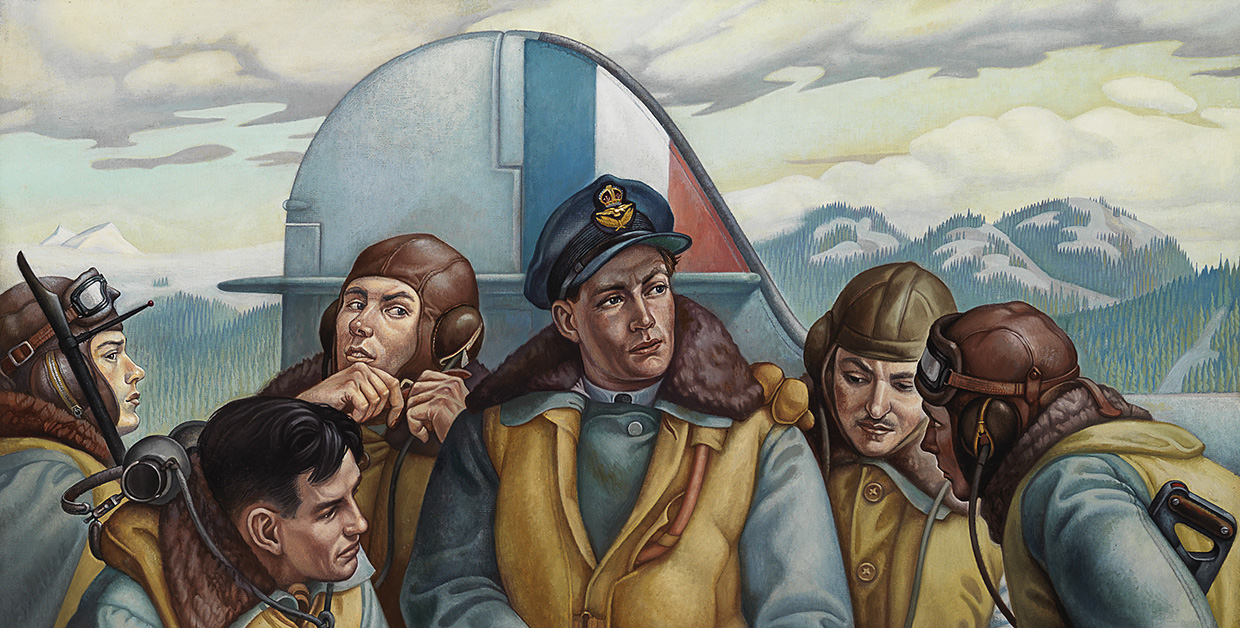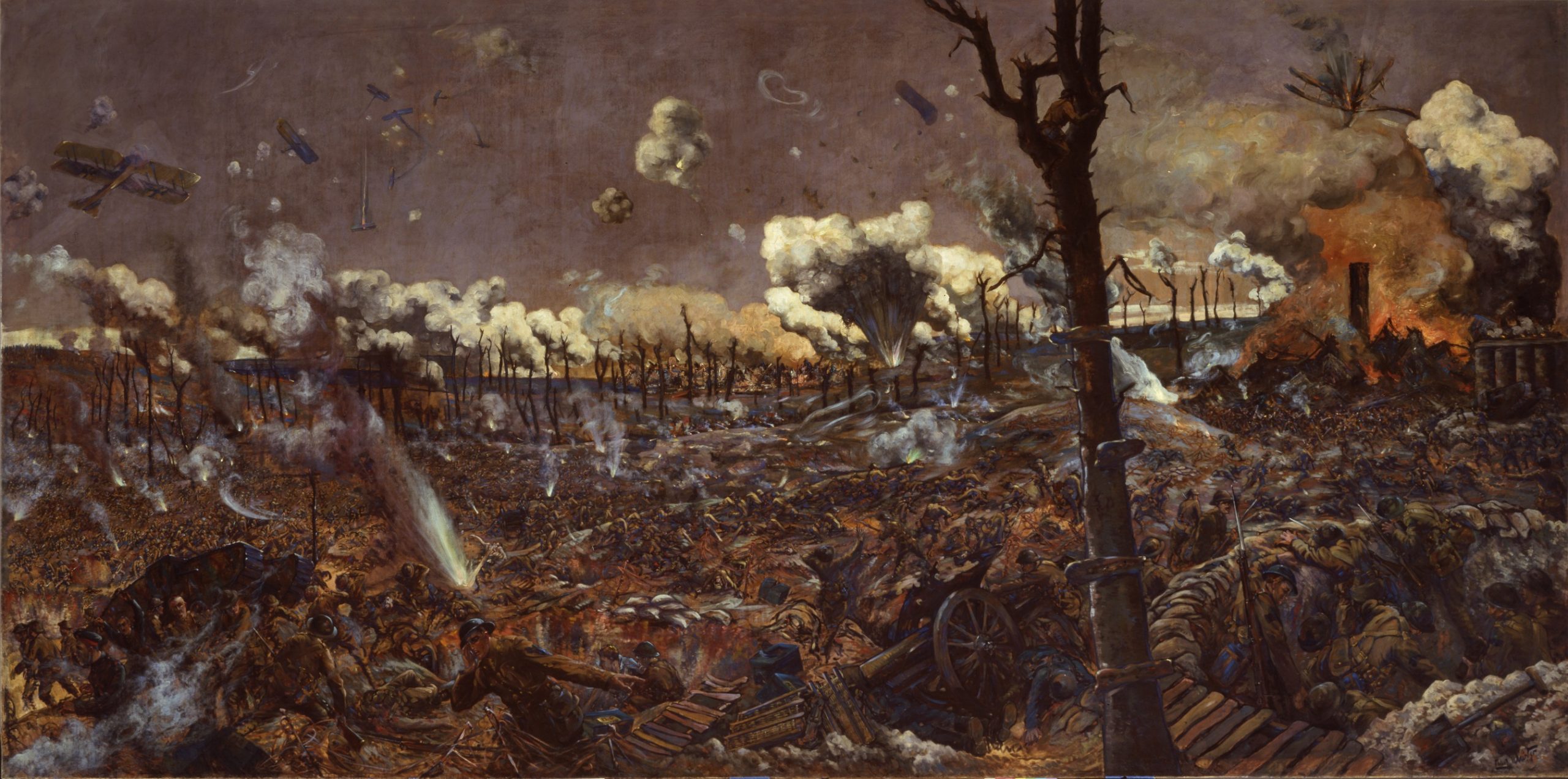From the series “Dispatches: Backgrounders in Canadian Military History”
The Atlantic Wall
(Note that some of the content in this series is outdated and is under review.)
In the summer of 1940 Britain faced a hostile coast from the Arctic Circle to the Spanish border. It appeared inevitable that Germany would use its control of the French Channel ports of Boulogne, Calais, and Dunkirk to invade Britain. That autumn, however, the Royal Air Force defeated the German air force in the crucial battle for air supremacy over the British Isles. Consequently, Adolf Hitler delayed and then shelved plans for the invasion.
By 1942, fearing an Allied invasion in the west while embroiled in war with the Soviet Union in the east, Hitler imgendeavoured to create the “Atlantic Wall”, or “Fortress Europe”, by encrusting the Atlantic seacoast with concrete and steel defences.
The foundations for some of the largest German coastal artillery emplacements along the French coast were laid as early as 1940 in the Pas de Calais region, a mere 40 kilometres across the English Channel from Dover. These gun positions originally were intended to support a German invasion of Britain. Subsequently, they fired on Allied shipping in the Channel and regularly shelled Dover, Folkestone and elsewhere along the British coast.
The Germans could not fortify the whole of the western European seaboard with such large and heavily-armed installations. The main portion of the Atlantic Wall stretched some 2000 kilometres from Denmark to the Spanish-French border. German military engineers built observation bunkers at wide intervals all along the coast. Lookouts in these bunkers could give warning of an Allied attack and direct naval, air and mobile land forces to the scene. Some 15,000 bunkers and other installations protected harbours and points along the shore where there were important facilities or likely landing spots. Barbed wire, minefields and other obstacles provided the first line of defence against Allied infantry and tanks. Small bunkers containing machine guns or light artillery covered these positions and protected the long-range artillery batteries. These batteries received a two-metre thick protection of steel-reinforced concrete to protect them against Allied naval and air bombardment. Hitler personally sketched many of the bunker designs, down to the smallest detail. From 1942, the Todt Organization, a labour mobilization system notorious for its use of forced and slave labour, built most of the bunkers but thousands of German troops also toiled to prepare the Atlantic Wall defences.
Canadian and British troops first confronted the Atlantic Wall during the disastrous Dieppe Raid in August 1942. The 5000 Canadians, drawn from the 2nd Infantry Division, suffered appalling casualties in a futile attempt to storm ashore in the face of withering fire from expertly-sited German positions. The failure of this operation underlined the need for lavish fire support – from the air, from the sea, and from special armoured vehicles put ashore with the infantry – if an invasion was to succeed. On the German side, the raid spurred greater construction efforts. By 1943, 250,000 workers poured up to 800,000 tons of concrete monthly into sophisticated fortifications, some of immense proportions. In the period 1942-1944, the Germans used over 17 million cubic metres of concrete and 1.2 million metric tons of steel for the Atlantic Wall. “I am the greatest fortress builder of all time”, boasted Adolf Hitler, who never once visited the Channel fortifications.

Fortunately for the Allies, the sheer scale of the project exceeded German resources. Berlin’s other priorities, especially the Eastern Front and air defence of the homeland against bombers, siphoned off enormous quantities of material and labour which might otherwise have been used on the Atlantic Wall. In 1943, the German commander in the Pas de Calais admitted that the Wall was, at best, a “thin, in many places fragile, length of cord with a few small knots at isolated points.” The most likely area for an Allied invasion attempt, a 500-kilometre stretch of coast from Calais to Cherbourg, contained the heaviest concentration of fortifications, including huge coastal artillery emplacements at Boulogne, Cap Gris Nez, Calais, and Dunkirk. The calibre of these guns was as large as 406 mm (16-inch), among the most powerful in the world.
For this reason, Allied strategists selected the less heavily defended Normandy beaches for their invasion of France in June 1944, even though Normandy was further from Britain than the Pas de Calais and less convenient for the eventual thrust towards Germany. Thousands of aircraft and hundreds of warships covered the initial Allied assault by attacking German coastal defences. Tanks fitted with amphibious equipment ‘swam’ ashore with the infantry. This massive effort caught the Germans by surprise (thanks in part to elaborate deception operations) and overwhelmed the coastal crust of defences. Although the weight of fire completely demoralized the garrisons, it actually destroyed very few fortifications, even by direct hits. Not far inland, the German mobile reserves stopped the Allied advance, and a brutal two-month battle of attrition began. Finally, at the end of July, while the Canadians and British pinned the Germans in the eastern sector of the bridgehead, United States forces ended the stalemate by launching a successful offensive in the west. The breakout from Normandy had begun. By September, the task of First Canadian Army, operating on the left flank of the Allied advance, was to drive the Germans from their largest Atlantic Wall bastions.
First Canadian Army captures the Channel Ports
The Allies raced rapidly through France and Belgium. With the Germans demoralized and apparently beaten, the end of the war seemed at hand. But Allied commanders argued over their options: should they move to open the approaches to the great port of Antwerp or advance on the Ruhr valley, Germany’s industrial heartland? Serious resupply problems aggravated the situation and further slowed the advance. The German defenders recovered their balance, maintained their grip on Holland, and reinforced their Atlantic Wall garrisons in the Pas de Calais.
General H.D.G. Crerar, First Canadian Army commander, had two army corps under his command: I British and II Canadian. Crerar ordered the British to open the port of Le Havre, and the Canadians to clear the Channel coast as far as Holland. The Germans withdrew most of their nearly surrounded forces and formed a new defensive line north of Antwerp. Some Atlantic Wall garrisons stayed behind, however, obeying Hitler’s order that Dunkirk, Boulogne, and Le Havre be defended to the last man. (Hitler later added Calais to the list.) All lay directly in the path of First Canadian Army.
Allied planners believed these Channel ports to be important for resupplying the Allied armies in their drive towards Germany. On September 9, General Crerar sent the following message to his corps commanders: “A speedy and victorious conclusion of the war now depends, fundamentally, upon the capture by First Cdn Army of the Channel ports which have now become so essential.”
The heavy gun positions in the Channel ports were carefully sited for mutual support and encased in steel and concrete bunkers. Built on high cliffs and pointed to seaward (few could fire inland), they were virtually impregnable to a frontal assault. But they also suffered from some important weaknesses. Because German commanders did not seriously fortify the land approaches to their positions until the Normandy front collapsed, the usual array of anti-tank ditches, minefields, and barbed wire, while formidable, was incomplete. The garrisons, moreover, included few battle-hardened troops. One of their own commanders described them as “fortress troops, sailors, home guards, harbour technicians and stragglers” of dubious fighting quality. Cut off behind enemy lines, their morale was poor; faced with death or capture, most opted unhesitatingly for the latter.
Because such weaknesses were not immediately evident, British and Canadian troops approached the fortresses warily. British troops under Canadian command first captured Le Havre on September 12 after devastating air, naval, and artillery attacks. On the 17th, it was Boulogne’s turn. The objective of Major-General Daniel Spry’s 3rd Canadian Infantry Division was to “capture Boulogne and destroy its garrison”, which numbered nearly 10,000 men. Prior to the assault, Canadian commanders concluded Boulogne would be a tough nut to crack and that the objective would have to be ‘softened up’ first. After waves of heavy and medium bombers saturated the defences, massive artillery barrages from 328 British and Canadian guns rained thousands of shells on the target. Flail tanks (tanks mounting a drum on the front fitted with coils of chain) then pounded paths through minefields for armoured infantry carriers and other tanks carrying flame throwers and bunker-busting explosive charges. This enabled the infantry to attack the defensive positions. Nevertheless, the German bunkers were so well constructed that one Canadian officer remarked the armour-piercing shells of the Canadians’ Sherman tanks “used to bounce off the installations like peas on a tin roof.”

Though Spry’s division lacked naval gunfire support, he did have an unusual substitute. Two 14-inch and two 15-inch British guns firing from Dover shelled German coastal positions in the Calais-Cap Gris Nez area up the coast from Boulogne to prevent the massive 16-inch guns there from disrupting the Canadian attack. Boulogne’s German commander later remarked that he knew “when the attack did come it would be thoroughly prepared to the last weapon, and that the Canadians would attempt to take the port with as few casualties as possible.” He was correct in more ways than one, for as the attack neared, the Canadians and Germans, concerned about civilian casualties, negotiated an agreement to evacuate 8000 residents from the city. Despite massive artillery and bomber support (nearly 800 aircraft dropping 3200 tons of bombs on September 17), few of the German defensive installations were seriously damaged. It still took infantry and tanks six days to secure the fortress-port. The Canadians lost 634 killed, wounded and missing; they captured over 9500 Germans.
Boulogne’s port facilities had been severely damaged and, in any event, could not be used effectively until the Allies reduced the nearby batteries at Cap Gris Nez and Calais. These were equally formidable. A combination of natural and constructed defences surrounded Calais, the location of no less than seven heavy coastal batteries. A somewhat lacklustre garrison of over 7500 men defended the flooded landscape dotted with concrete bunkers linked by barbed wire and minefields and covered by artillery and anti-tank guns. The 3rd Division watched as hundreds of bombers dropped their loads for three successive days prior to the assault, which began on September 25. Artillery fire drenched each German bastion in turn to allow flame-throwing tanks to get close enough to perform their grisly tasks. This kind of pressure ground down the morale of the defenders, causing some to surrender after only token resistance. On October 1 the fight for Calais and its great guns ended. The Canadians suffered about 300 casualties and took 7500 prisoners. As at Boulogne, the port installations in Calais, so needed to resupply the Allied armies, were badly damaged.
The other major German Atlantic Wall positions in the Pas de Calais were the colossal gun positions at Cap Gris Nez. These consisted of three main batteries, including one, Battery Todt, whose four 380 mm (15-inch) guns had intermittently shelled Dover since 1940. The Canadians followed the same successful plan of attack as used at Boulogne and Calais: massive aerial bombardment and supporting artillery fire. The 3rd Division’s 9 Brigade made the assault at dawn on September 29. Flail and bunker-busting “Petard” tanks provided support. “When our troops moved up to engage the batteries on the coast”, an officer of the 1st Hussars (6th Canadian Armoured Regiment) recalled, “they found that the Hun was prepared to snipe at our tanks with anything up to 360 mm calibre guns. The shells from those became known as ‘freight trains’ mainly because they whooshed by with a terrifying noise. It sort of shook us to see what they could do…”
The War Diary of the Ontario-based Highland Light Infantry (HLI) of Canada for September 29 states: “The artillery opened up and laid down a terrific barrage… which was very effective in keeping the enemy’s heads down. As soon as our troops got into the enemy positions the white flags started popping up… By 1030 all four big guns had been taken by the HLI, and the North Nova Scotia Highlanders reported they had cleared up the four on their front… The battalion tonight is in high spirits after its successful effort today. Now the people of Dover can relax… knowing that the cross-channel guns are silenced.” The costs were relatively light: eight killed and 34 wounded. Over 1600 Germans surrendered.
First Canadian Army demonstrated a high degree of skill and professionalism in capturing some of the most sophisticated defensive positions in Europe and in overcoming the impressive military engineering feat that was the Atlantic Wall.
Further reading
- Canadian War Museum, Democracy at War: Canadian Newspapers and the Second World War, D-Day and the Normandy Campaign
Very little has been written about First Canadian Army’s liberation of the Channel ports. Some of the most useful sources are:
- C.P. Stacey, The Victory Campaign, Queen’s Printer, Ottawa, 1966.
- Terry Copp and Robert Vogel, Maple Leaf Route: Antwerp, Alma, Ontario, 1984.
- Battlefield Interviews: The Channel Ports, September 1944, ,Canadian Military History, Vol. 3, No. 2, 1994.
On the Atlantic Wall, consult:
- Keith Mallory and Arvid Ottar, The Architecture of War, Pantheon Books, New York, 1973.
- Colin Partridge, Hitler’s Atlantic Wall, D.I Publications, Guernsey, 1976.



